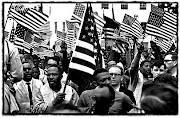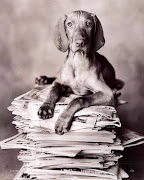
Fashion features style. Style changes, wearing out its welcome in the blink of a jaundiced fashionista's eye. One thing stays and  sticks no matter the fashion model. Black is the new black. Skin. July 2008 will be a historic edition of Vogue Italia as the fashion rag of record features only black models or those of African heritage. There have been many an edition featuring only white models as normal for haute couture in the course of the monthly publication.
sticks no matter the fashion model. Black is the new black. Skin. July 2008 will be a historic edition of Vogue Italia as the fashion rag of record features only black models or those of African heritage. There have been many an edition featuring only white models as normal for haute couture in the course of the monthly publication.
This will be the first time a major magazine features women of color on the cover and on each page requiring a model. Mixed ethnic or outright African supermodels come from all over the world and one or two notable brown sets of cheekbones have the iconic status of one name, but not the opportunities or dividends paid to their white counterparts. Sadly, this historic issue is a result of pressure brought about from protests comprised of designers, models and their agents in New York City. The issue is photographed by Steven Meisel, Pat McGrath on makeup with Guido Palau wielding the golden blow dryer and silver hair brush. Interspersed amongst the fashion pictorials are stories about black women in the arts and entertainment in the issue edited by Franca Sozzani.

 catwalks and continuously demonstrates she has a Prada she-devil of a time controlling her narcissistic temper. However, she has rightly and justly stated she is a woman of color alone inside the power corridors of a pasty vanilla fashion world. We are so fortunate that concurrently American Vogue will deign to touch the topic with an article lamenting and showcasing the lack of black models in fashion. US Vogue decides who is in the magazine. They have not found the black fashion market one to cultivate as preservation of entitled exclusivity of deciding who is in the magazine is by a multitude of editors, production assistants and bean counters that are predominantly Caucasians. These management attitudes are dopey descendants of the unenlightened supremacist editorial direction deciding black models would play to stereotypes if the motifs were African inspired and they remain pigeon holed.
catwalks and continuously demonstrates she has a Prada she-devil of a time controlling her narcissistic temper. However, she has rightly and justly stated she is a woman of color alone inside the power corridors of a pasty vanilla fashion world. We are so fortunate that concurrently American Vogue will deign to touch the topic with an article lamenting and showcasing the lack of black models in fashion. US Vogue decides who is in the magazine. They have not found the black fashion market one to cultivate as preservation of entitled exclusivity of deciding who is in the magazine is by a multitude of editors, production assistants and bean counters that are predominantly Caucasians. These management attitudes are dopey descendants of the unenlightened supremacist editorial direction deciding black models would play to stereotypes if the motifs were African inspired and they remain pigeon holed.
 Black style saw an unbelievable uptick this week when the six foot tall model-like Mrs. Barack Obama co-hosted "The View" on American television sporting a black and white dress that sold out in a chain of stores ironically named White House Black Market. NBC's Today Show featured the designer, Donna Ricco, of Michelle's sleek tank dress. Runways in 2008 featured lineups with models of African descent for fall collections during fashion weeks all over the world. It highlights the problem that black people are interchangeable fashion icons rather than intrinsic insiders of the fashion management milieu. Diversity is a feature of everyday life rather than notable exceptions needing special editions or fashion footnotes. In the 1950's Paris embraced Josephine Baker and other notable people of color from entertainment, but not a full integration at all levels of society high and low throughout Europe and it continues today.
Black style saw an unbelievable uptick this week when the six foot tall model-like Mrs. Barack Obama co-hosted "The View" on American television sporting a black and white dress that sold out in a chain of stores ironically named White House Black Market. NBC's Today Show featured the designer, Donna Ricco, of Michelle's sleek tank dress. Runways in 2008 featured lineups with models of African descent for fall collections during fashion weeks all over the world. It highlights the problem that black people are interchangeable fashion icons rather than intrinsic insiders of the fashion management milieu. Diversity is a feature of everyday life rather than notable exceptions needing special editions or fashion footnotes. In the 1950's Paris embraced Josephine Baker and other notable people of color from entertainment, but not a full integration at all levels of society high and low throughout Europe and it continues today.

Money sparks the bottom line discussion as covers are judged by how well they sell. The market to which the magazine is targeted is predominantly white. Magazine sales figures fluctuate even with the stunning physical glory of Naomi on the cover. Not only does the model selection need consistent diversification, but so do the positions behind the cameras and the homogeneous editorial staffs could certainly expand their ranks and market possibilities. The recently departed courtier creator of prêt-a-porter, Yves Saint Laurent, the first major designer to use a black model on the runway, should be an inspiration to more designers and editors to follow in his footsteps. Fashion is about color - it should also appreciate its naturalness on the model as well.
Featured in the historic issue of Vogue Italy comes the enthralling story of a Sudanese supermodel, Alek Wek, demonstrating the photogenic look that stuns. Her autobiography is in the aptly named, Alek: From Sudanese Refugee to International Supermodel.

 sticks no matter the fashion model. Black is the new black. Skin. July 2008 will be a historic edition of Vogue Italia as the fashion rag of record features only black models or those of African heritage. There have been many an edition featuring only white models as normal for haute couture in the course of the monthly publication.
sticks no matter the fashion model. Black is the new black. Skin. July 2008 will be a historic edition of Vogue Italia as the fashion rag of record features only black models or those of African heritage. There have been many an edition featuring only white models as normal for haute couture in the course of the monthly publication.This will be the first time a major magazine features women of color on the cover and on each page requiring a model. Mixed ethnic or outright African supermodels come from all over the world and one or two notable brown sets of cheekbones have the iconic status of one name, but not the opportunities or dividends paid to their white counterparts. Sadly, this historic issue is a result of pressure brought about from protests comprised of designers, models and their agents in New York City. The issue is photographed by Steven Meisel, Pat McGrath on makeup with Guido Palau wielding the golden blow dryer and silver hair brush. Interspersed amongst the fashion pictorials are stories about black women in the arts and entertainment in the issue edited by Franca Sozzani.

Naomi Campbell faces six months wearing the same outfit in a real prison, commands attention on the most famous designers' and dilettantesItalian Vogue's editor, Franca Sozzani, said her decision was influenced by the New York group, as well as by Barack Obama's success in the US presidential primaries.
Meisel said: "I thought, it's ridiculous, this discrimination. It's so crazy to live in such a narrow, narrow place. Age, weight, sexuality, race - every kind of prejudice.
"I have asked my advertising clients so many times, 'Can we use a black girl?' They say no."
 catwalks and continuously demonstrates she has a Prada she-devil of a time controlling her narcissistic temper. However, she has rightly and justly stated she is a woman of color alone inside the power corridors of a pasty vanilla fashion world. We are so fortunate that concurrently American Vogue will deign to touch the topic with an article lamenting and showcasing the lack of black models in fashion. US Vogue decides who is in the magazine. They have not found the black fashion market one to cultivate as preservation of entitled exclusivity of deciding who is in the magazine is by a multitude of editors, production assistants and bean counters that are predominantly Caucasians. These management attitudes are dopey descendants of the unenlightened supremacist editorial direction deciding black models would play to stereotypes if the motifs were African inspired and they remain pigeon holed.
catwalks and continuously demonstrates she has a Prada she-devil of a time controlling her narcissistic temper. However, she has rightly and justly stated she is a woman of color alone inside the power corridors of a pasty vanilla fashion world. We are so fortunate that concurrently American Vogue will deign to touch the topic with an article lamenting and showcasing the lack of black models in fashion. US Vogue decides who is in the magazine. They have not found the black fashion market one to cultivate as preservation of entitled exclusivity of deciding who is in the magazine is by a multitude of editors, production assistants and bean counters that are predominantly Caucasians. These management attitudes are dopey descendants of the unenlightened supremacist editorial direction deciding black models would play to stereotypes if the motifs were African inspired and they remain pigeon holed. Black style saw an unbelievable uptick this week when the six foot tall model-like Mrs. Barack Obama co-hosted "The View" on American television sporting a black and white dress that sold out in a chain of stores ironically named White House Black Market. NBC's Today Show featured the designer, Donna Ricco, of Michelle's sleek tank dress. Runways in 2008 featured lineups with models of African descent for fall collections during fashion weeks all over the world. It highlights the problem that black people are interchangeable fashion icons rather than intrinsic insiders of the fashion management milieu. Diversity is a feature of everyday life rather than notable exceptions needing special editions or fashion footnotes. In the 1950's Paris embraced Josephine Baker and other notable people of color from entertainment, but not a full integration at all levels of society high and low throughout Europe and it continues today.
Black style saw an unbelievable uptick this week when the six foot tall model-like Mrs. Barack Obama co-hosted "The View" on American television sporting a black and white dress that sold out in a chain of stores ironically named White House Black Market. NBC's Today Show featured the designer, Donna Ricco, of Michelle's sleek tank dress. Runways in 2008 featured lineups with models of African descent for fall collections during fashion weeks all over the world. It highlights the problem that black people are interchangeable fashion icons rather than intrinsic insiders of the fashion management milieu. Diversity is a feature of everyday life rather than notable exceptions needing special editions or fashion footnotes. In the 1950's Paris embraced Josephine Baker and other notable people of color from entertainment, but not a full integration at all levels of society high and low throughout Europe and it continues today.
Featured in the historic issue of Vogue Italy comes the enthralling story of a Sudanese supermodel, Alek Wek, demonstrating the photogenic look that stuns. Her autobiography is in the aptly named, Alek: From Sudanese Refugee to International Supermodel.











1 comment:
I love the first girl in black and white photo most. She is so special. The photo is really great and attractive. How worth to see the photo is. I love it indeed.
Her lips are so sweet as well.
Post a Comment